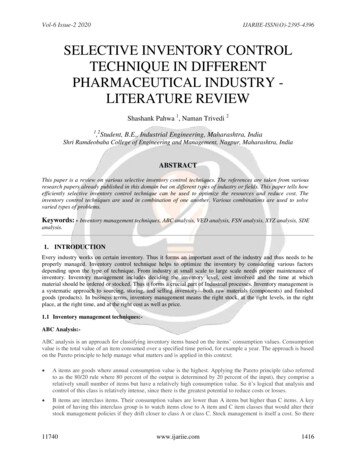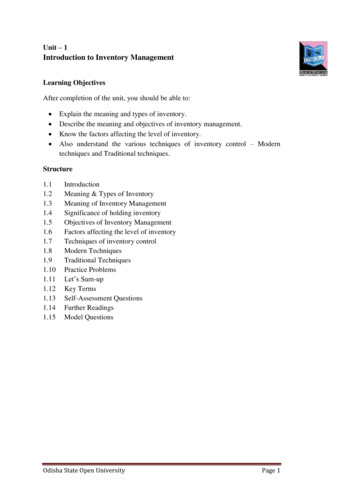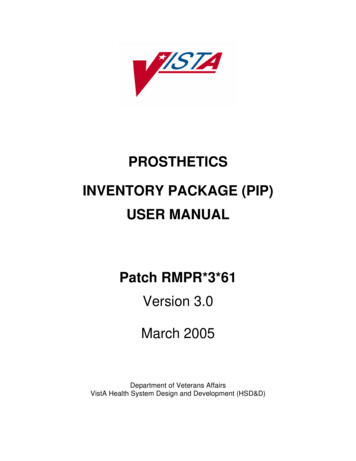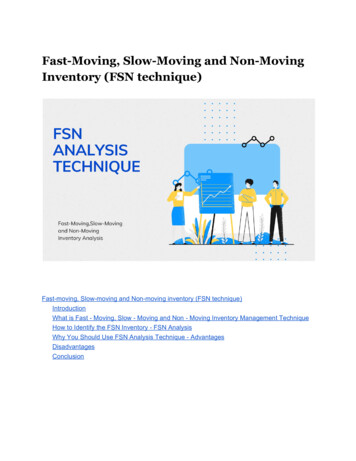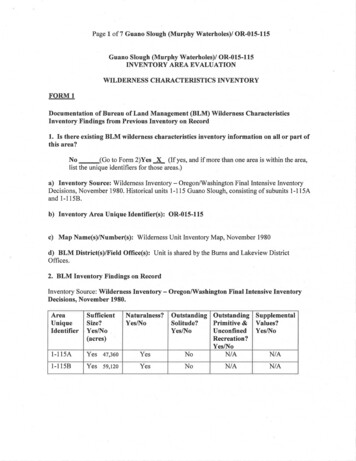
Transcription
International Journal of Engineering, Business and Management (IJEBM)ISSN: 2456-8678[Vol-6, Issue-2, Mar-Apr, 2022]Issue DOI: https://dx.doi.org/10.22161/ijebm.6.2Article DOI: https://dx.doi.org/10.22161/ijebm.6.2.5Effects of Inventory Control Management Systems onOrganization Performance in Tanzania ManufacturingIndustry- A Case Study of Food and BeverageManufacturing Company in Mwanza CityIrene Omari Mbugi, Sr. Dr Deusdedita LutegoDepartment of Finance and Accounting, St. Augustine University of Tanzania, Mwanza Campus, Tanzaniairenembugi1@gmail.comReceived: 28 Jan 2022; Received in revised form: 09 Mar 2022; Accepted: 18 Mar 2022; Available online: 29 Mar 2022 2022 The Author(s). Published by AI Publications. This is an open access article under the CC BY 0/)Abstract— This study was about the effect of inventory control management systems on organizationperformance in Tanzania manufacturing industry: a case study of food and beverage manufacturingcompany in Mwanza City. The specific objectives of the study were to: determine the types and purposes ofinventory control management practices followed ascertain the influence of inventory control managementpractices on organizational performance and determine how technology adopted in operationalization ofinventory control management practices affect organization performance. In order to accomplish theobjectives, qualitative approach methodwas adopted. Using purposive sampling, five participants in theinventory and production department were selected and interviewed. Data was analyzed using contentanalysis techniques with the aid of Nvivo Qualitative Analysis software. Other data was collected fromdocumentary review company and industry published reports. The findings of the study revealed that thefood and beverage manufacturing company had evidence of different types of inventories which includedraw materials, work-in-progress and finished goods managed under FIFO system for cost reduction andproduction efficiency. It was also evident that the company carried inventory control management usingperpetual inventory system done on periodic basis and inventory system is combined with acomputerizeddatabase of inventory quantities at various locations for up-dating in real time by store and warehouseusing barcode scanners. It was also revealed that inventory control management system using principles ofEconomic order quantity [EOQ]affects organizational performance in terms of cost reduction, productionefficiency, flexibility and profitability. The study recommends an implementation of new practices/modelssuch as Vendor Managed Inventory (VMI) in the company’s inventory control management.Keywords— Inventory Control Management Practices, Organizational Performance, EOQ.I.INTRODUCTIONManaging assets of kinds by organizations across theworld can be viewed as an inventory challenge to public aswell as private organizations. This is because both publicand private organizations tend to experience severaldifficulties in managing their inventories. The mostobserved challenge is that poor inventory can lead to understocking while over stocking may result in increased totalcosts of inventory (Koumanakos, 2008). Organisations canhttps://www.aipublications.com/ijebmovercome the challenge by utilizing sound controltechniques or systems suchas economic order quantities(EOQ) model to ensure effective inventory supervision,which in turn may lead to purchasing favorable quantitiesof raw materials for input in the production process.However, is mostly afforded by large organizations due tolarge capital investment and use of sophisticatedtechnology.56
Irene et al. / Effects of Inventory Control Management Systems on Organization Performance in Tanzania ManufacturingIndustry- A Case Study of Food and Beverage Manufacturing Company in Mwanza CityRegardless of level of sophistication of control system, it isargued that inventory has to be leveled down in order tomaximize storage costs and to boost up inventory to thelevel of customers’ demand in the target market (Medard2013; Atnafuand Balda 2018). One of the plausible ways isto avoid placing a lot of capital in inventory but this maysubsequently lead to dwindling of profitability andcashflow. It thus implies that the chain supply inventorypersonnel need to have competence in procurementprocess as deficiency of or limited facts and skills inprocurement.Furthermore, an inventory control system is vital becauseit ensures that assets and stock are adequately managedand that precise demand forecasting is maintained tominimize unexpected procurement operations. This willhelp the company execute effective procurementprocedures that meet market demand and supplier factors(Brigham & Gapenski, 2013).Agus & Noor (2010) alsostated that precise forecasting of demand allows thebusiness to reduce operating expenses, improvedefficiency and on time supply of products and services forthe future requirements by fulfilling the growingexpectations of customers. This leads to increasedconsumer fulfilment as the outcome of the best value ofproducts and services provided, also improvedorganizational effectiveness. In a similar vein, previousstudies have established that improper inventories controlmanagement may cost an organization a loss ranging from25 percent to 40 percent of the expected value, resultingfrom lost sales as a direct consequence of customerdissatisfaction (Makweba and Xi, 2009). Thus efficientinventory control system is part and parcel of supply chainactivities to enable the organization to have sustainablecompetitive edge in the market and to improve firm’sprofitability as well. In spite of the importance ofinventory control systems in organizations, such asTanzanian manufacturing firms including food andbeverage production companies, there is paucity ofempirical research of the effect of inventory control systemon organizational performance.Statement of the Research ProblemManufacturing firms have become less competitive in themarket due poor inventory control systems. Tanzanianmanufacturing beverage companies such as those found inMwanza City are facing competition from othermanufacturing companies in other parts of the countrywhere they need to assume more effectual techniques ofregulating and managing inventory through removingwaste in the production process, reducing holding costs,ordering costs and many ss manufacturing establishments have adoptedinventory management systems in their efforts to survivein the markets as well as to improve their businessoperations. However, in what way the inventory controlschemes they apply affect organizations’ performance ofmanufacturing companies, in particular food and beveragemanufacturing companies in Tanzania has not beenstudied.Inventory control management's impact on organizationalefficiency has been a contentious topic to both scholarsand researchers as they hold different views and findingsabout its influence on an organizational performance.Mukopi and Iravo (2015), for example, discovered thatinventory management had a favorable impact onperformance. Similarly, Mogere, Oloko and Okibo (2013)found that there is a substantial link between inventorycontrol management and organizational performance. Bothstudies were conducted in Kenya in the setting of sugarindustry and tea industry respectively. However, aNigerian study by Otuya and Eginiwin (2017) amongSMEs in Delta State, revealed there was no direct linkbetween the two variables of inventory controlmanagement and organizational performance. In Nigeria,certain empirical research have also been conducted in thecontexts of engineering firms, manufacturing and cementindustries but none in the food and beverage industry(Eneje, Nweze and Udeh (2012); Duru, Okpe & Udeji(2014).In the context of Tanzania exists few empirical studies oninventory control systems such as that by Ondyeki (2019)focused on inventory control system of assets and theirsafety in public secto while Medard (2017) focused therelationship between inventory control and management ofassets also in public sector. Besides, the majority of studiesfor example, Otuya & Eginiwin, 2017; Otuya &Eginiwin2017; Atnafuand Balda, 2018) have adoptedquantitative approach and have not obtained deep insightsof how inventory control systems contribute toorganizational performance and yet manufacturing foodand beverage firms have intensive capital in inventorieswhose management is vital to company’s sustainability ina competitive market. Hence, this study fills theknowledge by investigating using qualitative approach theeffects of inventory control management systems onorganizational performance in Tanzania manufacturingindustry in the selected food and beverage manufacturingcompany in Mwanza City. Based on these gap identifiedand discussions made on empirical and theoreticalevidences, the following basic research questions wereformulated.57
Irene et al. / Effects of Inventory Control Management Systems on Organization Performance in Tanzania ManufacturingIndustry- A Case Study of Food and Beverage Manufacturing Company in Mwanza City(i) What influence inventory control managementpractices have on organizational performance of thefood and beverage manufacturing company inMwanza city?(ii) How technology adopted in operationalization of theinventory control management practices affectorganizational performance in the food and beveragemanufacturing company in Mwanza city?II.LITERATURE REVIEW2.1 Theoretical ReviewAccording to Kafyetta (2016), an inventory control systemmanagement is a arrangement that systematizes allinventory management activities. These systems aredescribed to integral successfulness of any businessorganization and are principally used to proficientlycapture stock movements using both hardware andsoftware gears in supply chain. Inventory management,according to Saleemi (2004), is a critical issue in everyfirm that should not be disregarded. The goal is to saveprecious investment while lowering expenses andenhancing affordability. He goes on to say that the majorgoal of inventory control is to reduce lazy time producedby stocks shortages and non-availability of stocks, as wellas inventory carrying cost expiration losses.2.1.1 Types of Inventory Control SystemsInventory control systems are viewed as necessarycomponents in day – to- day operations of an organization,whose significance to enhance organizational performance.According Ali et al (2014), the following are types ofinventory control system: shipping, purchasing, receiving,warehouse storage, turnover, tracking, and reordering ofinputs. Nevertheless, there is no a common ground amongmanagers and scholars to what makes the differencebetween stock organization and stock control systems, asan effective inventory control system entail inventorymanagement and vice versa to increase supply chainproductivity and efficiency so that the correct inventory isavailable at the right time to satisfy client demands (Adoga& Valverde, 2014). From En- Kanselu’s (2008)perspective there are two forms of inventory controlsystems which organizations can employ; explicitly,perpetual inventory control systems and periodic inventorycontrol systems. En- Kanselu further informs that withinthese two systems, there are two sub systems of inventorycontrol management systems: barcode systems and radiofrequency identification (RFID) systems.2.1.1.1 Perpetual Inventory Control SystemsThe perpetual inventory control system is concerned withregular updating inventory records and accounts at anyhttps://www.aipublications.com/ijebmtime when inventory Items are collected, traded frominventory, transported as of one area to alternative,retrieved from inventory, and discarded. (En-kanselu2008). The author further points out that, someestablishments prefer perpetual inventory control systemsbecause they deliver up-to-date inventory information andbetter hold negligible manual inventory counts. They arealso chosen to because they are considered fast an accuratein capturing inventory on continual basis when they arethey are properly utilized and managed (En-Kanselu,2008). For the matter of emphasis, Chopra (2015) adds thatperpetual inventory control performs better when usedtogether with a database of inventory amounts bystoreroom staffs using barcode scanners.In spite of the importance, they have for the betterperformance of the organization, perpetual inventorycontrol systems have observed short comings. First, thesesystems are technologically dependent as it is impossibleto maintain them manually. Instead, they require technicalequipments and software, which results in a large rate ofexecution, particularly for businesses with a great numberof locations or warehouses. In addition, they neednecessary periodic maintenance and upgrades, which alsoadd extra cost.Second, because they do not employ a consistentinventory system, a perpetual inventory system may causerecorded inventory to differ from real inventory over time.Third, since so much time occurs between physicalinventory counts, they make it problematic to discoverwhere inconsistencies in inventory amounts arise whenemploying a periodic inventory management system (Enkanselu, 2008). As a result, inaccuracies, stolen products,and inadequately scanned objects have an impact on theinventory that is recorded creating an expected deviationfrom the actual inventory counts. Therefore, the choiceand use of any inventory control system need carefulconsideration considering strengths and weaknesses it has,and on top of this its impact on an organizationalperformance.2.1.1.2 Periodic Inventory Systems.On the side of periodic inventory control systems, they donot pathway inventory on a daily basis. Instead, they aresaid to consent establishments to comprehend the openingand finish level of inventory within certain duration oftime. These types of inventory control systems captureinventory by employing actual inventory amounts. Whenactual inventory is whole, the stability in the purchasesaccount moves into the inventory account and isaccustomed to concur with end inventory cost. They areuser friendly as there are few problems of using a periodicinventory system (Chopra, 2015).58
Irene et al. / Effects of Inventory Control Management Systems on Organization Performance in Tanzania ManufacturingIndustry- A Case Study of Food and Beverage Manufacturing Company in Mwanza City2.1.1.3Barcode Inventory Control SystemsBarcode inventory control systems are regarded moreprecise and effective than physical inventory operations.When utilized as fragment of an entire control inventorysystem, barcode systems instantly update levels ofinventory whenever labors scan them using a barcodescanner or mobile device. En-kanselu (2008) describes theadvantages of using bar-coding in inventory control systemmanagement procedures, such as maintaining precise dataof all inventory transactions, eliminating time-consumingdata errors that may occur frequently with manual or papersystems, and minimizing manual data entry errors.2.1.2 e are several inventory control management practicesor models underlying management of inventory controlsystem for the purpose of having the correct quantity ofinventory on hand to run a profitable and cost-effectivebusiness. It is said to apply mostly in large-scalebusinesses, such as manufacturing industries. Accordingto Adamu et al (2014), they are said to apply mostlyeffective in large-scale business organizations, such asmanufacturing industries. They include Stock Review,Automatic Replenishment, ABC Inventory Model, Just-InTime (JIT) Inventory, Economic Order Quantity EOQ) andVendor Managed Inventory.Stock review is construed to be the easiest inventorycontrol system management technique which is found tobe more favourable in small- scale organizations. Itsimplementation entails a frequent review of existinginventory against anticipated future demands. (Adamu etal, 2014). The stock review process is manually, yet incertain cases an automated stock review is used tocalculate the minimum stock level in order to assurecontinual inventory checks and supply reordering to satisfyminimal levels. Its only demerit is that it is labourintensive and also prone to errors; therefore, it needs muchcare in its application (Adamuet al, 2014).2.1.2.1 Vendor Managed InventoryVendor Managed Inventory (VMI) this is a supply networkapproach in which the contractor or supplier manages thebuyer's inventory (Smaros et al., 2003). For the purpose oftracking the customer's stock level, the vendor is grantedaccess to its purchaser's inventory and demandinformation. Furthermore, the vendor has the ability andduty to refill the purchaser's inventory in accordance withthe inventory control principles and objectives that havebeen mutually agreed upon (Smaros et al., 2003). It entailsplacing purchase orders in accordance with a long-terminventory degree schedule and shared forecast data. Aboost transport observer notifies the consumer ofhttps://www.aipublications.com/ijebmsubstances in transit as soon as the purchase order ispressed. Following that, the goods is sent, delivered, and"logged" according to the shipment procedure. However,the VMI concept is ideally used to the implementation ofinventories at retailer’s distribution middle. The advantageof VMI system is that customers are able to expel stockouts because suppliers may have replenished theirinventories (Potilen & Goldsby, 2003).2.1.2.2 Economic Order Quantity (EOQ)According to Ogbo (2011), the economic Order quantity(EOQ) refers to ordering amounts that reduce the cost ofinventory stability while maintaining pricing in proportionto re-order costs EOQ requires the following assumptions,according to Onwubolu et al. (2006): (i) Demand is knownand constant; (ii) Lead-time is known and constant; (iii)Inventory is received in one batch, at one time; (iv)Quantity discounts are not possible, (v) The only variablecosts are the cost of placing an order and the cost ofholding inventory; and (vii) Stock-outs can be completelyavoided if orders are placed at the right time. With theseassumptions inventory usage over time has a saw toothtype of characteristic which means that the graph of theinventory usage undergoes gradual variations.As compared to other inventory control managementpractices, the EOQ method renders, to some considerableextent, complications in application of it. The reason givenis that it requires an organization to understand the yearlyusage in units, ordering value in greenbacks according toorder, annual sporting cost charge, unit value in dollars,and order amount in gadgets are the following records.Nevertheless, the merit attributed to EOQ method is that itstrives to locate the order quantity that has the minimumtotal price of carrying the stock for the purpose ofminimizing the holding costs (Mandal, 2012). In otherwords, EOQ is cost effective as it helps an organization tocut down business running costs. Therefore, it is a viableinventory control management practice which can be usedby an organization in order to attain high profitability.They are assumptions necessary in basis of EOQ.2.1.2.3 Just-In Time (JIT) InventoryJust-In-Time technique is construed as aggregatedpractices that are used to do away with waste whereinmaterials, parts, and in place ordering immediatelydifferent items needed to meet instantly manufacturingrequirements (Mazanai (2012). These large-scale businessmethods are thought to cover the full inventory supplychain. Shared product design with suppliers and customers,moving away from incompatible sourcing nearbysuppliers, minimal machine determined times, and overallpreventative protection are all identified components ofJIT (Mazanai, 2012).59
Irene et al. / Effects of Inventory Control Management Systems on Organization Performance in Tanzania ManufacturingIndustry- A Case Study of Food and Beverage Manufacturing Company in Mwanza CityAccording to Mazanai (2012), JIT is an inventorytechnique used to improve a commercial enterprise's returnon investment by reducing inventory and its associatedwearing fees, as well as enhancing performance and, as aresult, saving inventory management costs and lead timeexpenses.In an endeavor to obtain JIT, Bicheno (2016)argues that the process has to have indicators of what isgoing on everywhere inside the entire inventory system.JIT is said to result in significant improvements in amanufacturing company's return on the investment andoptimum performance. It underlines the importance ofmanufacturing in the creation of devices that is, usefultools or devices that arrive when needed, neither in earliertime nor later time but on time (Bicheno, 2016),Muchaedepi et al (2019) and Chase et al (2009), cited inAdeyemi and Salami (2010) Furthermore, a just-in-timeinventory system keeps stock levels low by only producingfor particular customer requests. The outcome is asignificant reduction in stock investment and scrapexpenditures, despite the fact that, as the above-mentionedauthors suggest, an excessive degree of coordination isrequired.According to Farzaneh (2012), JIT can eliminate garage,investment, insurance, ordering, and shipping costs.However, it is contingent on the current circumstances. Inthe ideal circumstance, when all of the parameters are met,it is more cost-effective to choose JIT over EOQ since itresults in a simultaneous reduction in purchase price,protection charge, and ordering fee, as Farzanehrecommends (2012).2.1.2.4 ABC Inventory ModelMandal (2012) believes that the ABC stock control schemeis entirely based on the principle that a small portion of theitems may specifically constitute a large portion of thecash price of the entire inventory used in the productionmethod, while a notably large portion of the cash price ofstores may be obtained. In line with this ABC technique tostock management, Ng (2007) observes that high valuegadgets are more closely controlled than low cost items. Itis elaborated that in application o ABC Inventory Model,depending on the quantity paid for that specific item, eachstock item is allocated an A, B, or C letter. "A" or the mostexpensive devices should be under the strict supervisionand responsibility of the most skilled employees, whilst"C" or the cheapest price can be under basic physicalcontrol. (Ng, 2007).Lyson (2006), on the other hand, comments thatABC assessment is a well-established categorizationapproach based on the Pareto principle for deciding whichobjects must be prioritized in the management of anorganization's stock. generally, ABC analysis is thought tohttps://www.aipublications.com/ijebmbe a method for prioritizing the management of inventoryand inventories classified into three domains-A, B, and C.Dealing with A items necessitates the most managerialeffort and attention. C things receive the least attention,whereas B goods fall somewhere in the middle (Lyson2012; Lyson &Farrington, 2006).2.1.2.4 Automatic ReplenishmentAnother inventory management technique is the automaticreplenishment model. Vijay (2004) in Kitheka (2012)defines automation as a technique dealing with theapplication of mechatIronics and computer systems forproducing products and services at a factory. According toGitau (2016). Most organizations automate to addressconcerns such as labor shortages and high labor costs, aswell as to increase productivity and minimizemanufacturing lead-times. All of this adds up to cheaperoperating costs and more sophisticated customer support asa result of automation. Stock can occur in a variety ofareas along the supply chain, as well as in variousdocuments such as raw materials inventory, work-inprocess (WIP), or finished goods inventory2.1.3 Organizational PerformanceOrganizational performance remains a central theme incontemporary literature and scholars are continuouslydiscussing various factors such as organizational structure(Awino 2015), strategic innovation (Shisia et al 2014) andhuman capital human capital (Odhon’g and Omolo 2015)that inform performance in diverse organizations. In thisstudy the focus is on inventory control system as a factorinfluencing performance.Lebans and Euske (2006) define performance as a measureof monetary and non- monetary pointers that indicateevidence about the grade of achievement of theorganization’s objectives. In most studies, performancemeasurement has been limited to a financial perspective,leading to various restrictions like emphasis on the internalfactors of the company and overdue accessibility ofperformance-related information.To overwhelmed these restrictions performance has to bemeasured as a multidimensional that includes financial andnon-financial indicators (Neely, 2002). For example, nonfinancial organizational performance can be attained byimprovement of product quality, refining productionefficiency, responsiveness to customers’ needs, customers’satisfaction, while financial indicators as profitability,return on investment, sales and lastly its market share.Brudan (2010) further stresses that; organizationalperformance measurements should involve identification,monitoring and communication of the results usingperformance indicators. In this research study,organizational performance, as influenced by inventory60
Irene et al. / Effects of Inventory Control Management Systems on Organization Performance in Tanzania ManufacturingIndustry- A Case Study of Food and Beverage Manufacturing Company in Mwanza Citysystems, are measured in regard with the followingindicators: profitability, cost reduction, flexibility andproduction efficiency.2.2Empirical reviewThere is already a body of researches carried out oninventory control systems in relation to their influence onorganizational performance across the globe and in variousindustries as well as in public institutions. The followingsections provide a review of some studies conducted inAfrican context, as they are more relevant to the currentstudy topic.2.2.1Inventory control management practices andorganization performancePrevious research has found a link between inventorymanagement strategies such as Economic Order Quantity(EOQ), Just in Time (JIT), Marginal analysis, vendorcontrolled inventory, and Order batching and agriculturalsector performance (Mwangi, 2013) as well as retailinstitutions (Omondi &Namusonge, 2015). Furthermore,inventory control has been discovered to have a straightinfluence on the road building schemes performance(Ang'ana, 2012).Similarly, Mogere, Oloko, and Okibo (2013) discovered agood relationship between the usage of materialrequirements, distribution planning, and vendor-controlledinventory and operational efficiency and organizationalperformance. As a case study, the research was conductedat the Gianchore tea facility in Kenya. Its goal was toevaluate inventory control systems impacts functioningroutine in the tea business by employing a designedquestionnaire as a information collection tool andregression data analysis.On the other side, Lwiki, Ojera, Mugenda and Wachira(2013) used both primary and secondary data to examinehow inventory management practices impact on financialperformance of selected firms. The study was carried outin the context of the Kenya sugar manufacturing firms.Through relationship analysis the results revealed thatinventory management impacts certainly on both return onsales and return on equity.Similarly, Kimaiyo and Onchiri (2014) investigated theimportance of inventory management on the performanceof new Kenya Cooperative Creameries. The study had asample size of 83 respondents selected from a targetdemographic of 500 people. The study used a descriptiveresearch approach to establish that inventory managementthrough holding stocks and ordering expenses tended toimprove company performance. According to the findingsof the study, the value of inventory control in supply t seems to be handled across a wide range ofindustries in Kenya.In the same vein, Mwangi and Nyambura (2015) did astudy in the context of companies involved in Kenyan foodprocessing sector. The focal point of the study was toexamine the role inventory management plays in theperformance of these companies. This study, like Mwangiand Nyambura (2015), used a descriptive researchapproach and multiple regression data analysis. Accordingto the findings, the essential features of inventorymanagement that had a vital impact in improving theperformance of food processing industries weremaintenance of production, controlling cost, declining lossrecord, and constant supply.Another study was by Wangari and Kagiri (2015) whichsought out find out the influence of inventory controlmanagement practices at Safaricom Kenya Ltd on itscompetitiveness edge in the market. The drop and pickquestionnaires from respondents’ method were used tocollect data which were analyzed through multipleregression analysis technique. According to the findings ofthe study, inventory venture, inventory shrinkage, andinventory incomings were important forecasters ofcompetitiveness in Safaricom Ltd and organisationaleffectiveness in the Kenyan market. Ngei and Kihara(2017), on the other hand, aimed to determine the impactof inventory control on the efficiency of gasolinemanufacturing enterprises in Nairobi City County. Thestudy used both primary and secondary data and they wereanalyzed using multiple regressions. The reported resultsfrom the study were that Vendor Managed Inventory(VMI), Enterprise Resource Planning (ERP), RadioFrequency Identification (RFID) and e-procurementsignificantly predicted performance of gas firms in theKenya.Atnafuand Balda (2018) empirically examined the impactof inventory management practices on firms’competitiveness and organizational performance in microand
Organization Performance in Tanzania Manufacturing Industry- A Case Study of Food and Beverage Manufacturing Company in Mwanza City Irene Omari Mbugi, Sr. Dr Deusdedita Lutego Department of Finance and Accounting, St. Augustine University of Tanzania, Mwanza Campus, Tanzania . (RFID) systems. 2.1.1.1 Perpetual Inventory Control Systems




